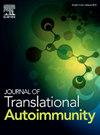An international multicenter retrospective analysis of repeated anti-ENA testing in ANA-associated rheumatic diseases, a data-driven proposal to increase testing efficacy
IF 3.6
Q2 IMMUNOLOGY
引用次数: 0
Abstract
Background
Autoantibodies detection in ANA-associated rheumatic diseases (AARD) is not only used for diagnostic and classification purposes, but also for monitoring. In case of AARD it is questioned if repeated anti-ENA testing is of any substantial value. In this international multicenter retrospective study, repeated anti-ENA testing according to local AARD testing algorithms was investigated.
Methods
Anti-ENA results (anti-SSA60, -Ro52, -SSB, -Scl-70, -CENP-B, -RNP, -Sm) over a 6 to 10-year period were extracted from the laboratory information systems of three participating centers. Time between repeated testing was determined and concordance analysis was performed.
Results
The study included 28557 anti-ENA requests from 19388 patients (72 % female). In 15227 patients (78.5 %) only one anti-ENA test was performed (79.9 % negative), while 4161 patients (21.5 %) underwent multiple (median [interquartile range (IQR)]; 2 [2–4]) tests with a maximum of 31 tests. The median [IQR] time interval between anti-ENA testing for the total cohort was 364 [195–539] days. Concordance analysis demonstrated that repeated anti-ENA test results did not show any change in 3583 patients (86.1 %). Additional autoantibodies were observed in 243 patients (5.8 %). In 76 (1.8 %) patients a positive anti-ENA test was obtained after an initial negative anti-ENA test result, while in 167 (4.0 %) patients additional autoantibodies were detected after an initial positive anti-ENA result.
Conclusions
Repeated anti-ENA testing with a median time interval of about one year is common independently of local laboratory testing algorithms, but showed a limited added value since only 1.8 % of the patients have demonstrated a positive anti-ENA test after an initial negative anti-ENA test. These data at least suggest that repeated anti-ENA tests should be discouraged and only be instigated by a change in clinical manifestations.
一项国际多中心回顾性分析,在ana相关的风湿病中反复进行抗ena检测,一项数据驱动的建议,以提高检测效果
自身抗体检测在ana相关性风湿病(AARD)中不仅用于诊断和分类,而且用于监测。在AARD的情况下,反复的抗ena测试是否有任何实质性的价值是值得怀疑的。在这项国际多中心回顾性研究中,研究了根据局部AARD检测算法进行的重复抗ena检测。方法从三个参与中心的实验室信息系统中提取6 ~ 10年间的抗- ena结果(抗- ssa60、-Ro52、-SSB、-Scl-70、-CENP-B、-RNP、-Sm)。确定重复试验的间隔时间并进行一致性分析。结果该研究包括19388例患者的28557份抗ena申请(72%为女性)。在15227例(78.5%)患者中,仅进行了一次抗ena检测(79.9%为阴性),而4161例(21.5%)患者进行了多次(中位数[四分位数范围(IQR)];2[2 - 4])个测试例,最多31个测试例。在整个队列中,抗ena检测的中位数[IQR]时间间隔为364[195-539]天。一致性分析表明,3583例(86.1%)患者的重复抗ena检测结果未显示任何变化。243例(5.8%)患者检测到自身抗体。在76例(1.8%)患者中,在最初的抗ena测试结果为阴性后,检测到抗ena阳性,而在167例(4.0%)患者中,在最初的抗ena阳性结果后检测到额外的自身抗体。结论:在独立于当地实验室检测算法的情况下,以中位时间间隔约一年进行重复的抗ena检测是很常见的,但其附加价值有限,因为在最初的抗ena检测阴性后,只有1.8%的患者显示出抗ena检测阳性。这些数据至少表明,应该不鼓励重复的抗ena试验,只有在临床表现发生变化时才应该进行。
本文章由计算机程序翻译,如有差异,请以英文原文为准。
求助全文
约1分钟内获得全文
求助全文
来源期刊

Journal of Translational Autoimmunity
Medicine-Immunology and Allergy
CiteScore
7.80
自引率
2.60%
发文量
33
审稿时长
55 days
 求助内容:
求助内容: 应助结果提醒方式:
应助结果提醒方式:


